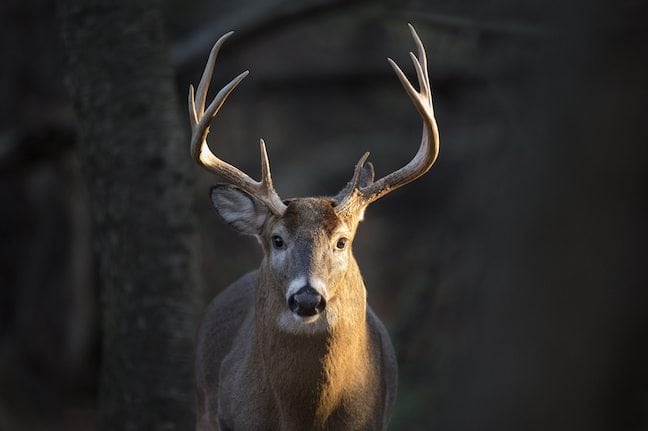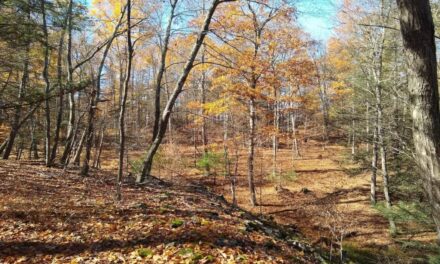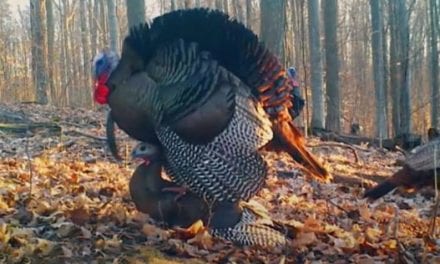There are many issues for the Louisiana deer herd, but the LDFW is constantly monitoring the herd for health and population levels.
By September, the stage is set for the final few acts of the unfolding summer drama as the earth passes through its autumnal equinox. Dove season has kicked off the hunting season, high school football has returned to the field, farmers are finishing harvests and the whole region guardedly watches the Gulf.
Though the astronomical summer has ended, temperatures continue to be sultry for a few more weeks. It is also time for deer hunters to begin considering putting the finishing touches on food plots or scouting new places for stands. Opening day of deer season is just around the corner.

Opening day of deer season is just around the corner. (Shutterstock image)
The Louisiana deer program is administered through two Louisiana Department of Fisheries and Wildlife statewide deer program biologists — one from Baton Rouge and the other from Pineville — and implemented through several regional offices where wildlife biologists and technicians perform year-round research and management activities on public and private lands.
Find more G&F articles on Louisiana Deer Hunting
According to Jonathan Bordelon, Deer Study leader, the 2015-2016 deer harvest was up nearly 22 percent from previous seasons, but down slightly (9 percent) in 2016-2017, when relying on the reporting system data only. Across the state harvest numbers seemed consistent, though local conditions play an enormous role in harvest. Northwest parishes had really good harvest numbers, and the relatively warm winter did not seem to hurt, while the river parishes seemed weaker, and the warm January didn’t help.
“One good bit of news I can report is related to a metric called lactation rate,” said Bordelon. “Essentially, lactation rate is a population-based measure describing the percent of female deer that are lactating (producing milk) at time of harvest. Lactation rates are recorded by clubs participating in DMAP, as well as by LDFW technicians and biologists on state lands. Female deer that are 2.5 years old are expected to have fawns and be lactating. In the past few seasons biologists had been measuring declining lactation rates, but based on data from October and November of 2016, we have seen improvements in the percentage of females in the 2.5-3.5 year age group.”
Biologists measured some of the highest rates seen in the last 10 years at Dewey Wills Wildlife Management Area, with nearly 80 percent of harvested does lactating, which bodes well for this season.
However, there are still a number of concerns biologists continue to monitor, such as the effects of wild hogs, zoonotic diseases and Chronic Wasting Disease.
Competing Hogs
Hogs also compete for the same resources as white-tailed deer, with research suggesting that deer detection rates can be up to 49 percent less in areas where hogs are found. Hog populations affect deer numbers through direct competition for food resources and even fawn predation. In addition, hogs carry and transmit a number of infectious diseases, such as Leptospirosis, Brucellosis, and pseudorabies. Zoonotic diseases are common in nature (spreading from one species to another), but can be greatly exacerbated by human activity.
The 2015-16 mail survey hog harvest estimate was 172,300, which is higher than the recorded deer harvest, possibly because hog hunting is open on private lands, with permits available for year-round night hunting and trapping.
The LDWF Deer Study Team routinely draws blood samples from harvested deer to be serologically evaluated for exposure to various diseases as part of the LDWF herd-health monitoring program. One of these diseases is a bacterial disease cause by multiple strains of Leptospira interrogans, which is transmitted from close association with hogs and other animals. In deer, Leptospirosis can cause severe illness and abortions in pregnant does.
G&F Trending Stories
- Best Deer Hunting Rifles of 2017
- Whitetail Deer: 4 P’s You Need to Consider
- Hurricane Harvey’s Impacts on Texas Hunting, Fishing
- Tag Your Bow Buck Early: Here’s What to Do
- 6 Bows for Whitetail Deer
“Looking at last season’s data (2015-2016), the exposure rate based on serological samples was 46.5 percent prevalence,” said Bordelon. “We have not obtained all of the results of 2016-2017 samples yet, but it does appear that prevalence in October and November samples was higher than during 2015-16 sample set. Unfortunately we do not have very good long-term data for Leptospirosis in the deer herd, but prevalence spikes have been observed over the short term. What causes the spikes is yet to be understood.”
The 2015-16 sample set also revealed 50 percent prevalence for Bluetongue and 44 percent prevalence for Epizootic Hemorrhagic Disease. The LDWF had 12 reported and confirmed cases of death due to hemorrhagic disease in white-tailed deer during the 2015-16 season.
“We do not expect to see significant changes in prevalence of either HD virus or bluetongue virus in the deer herd,” said Bordelon. “Deer in Louisiana face relativity high exposure rates and the viruses are in the population and really not of concern. We will, of course continue to monitor both viruses and use the data to assess the health of the herd.”
Biologists continue to investigate sick, injured or dead deer when observed by department personnel or when reported by the public.
Louisiana Deer Reg to Combate CWD
While CWD has been documented in 23 states, including in parts of Texas and Arkansas, thousands of samples taken from Louisiana deer (beginning in 2002) have been negative to date. In an effort to prevent the introduction of CWD in Louisiana’s white-tailed deer population, new regulations governing importation of white-tailed deer and other members of the family Cervidae (mule deer, elk, moose, caribou and others) carcasses into Louisiana went into effect March 1, of this year.
The regulation reads in part: “No person shall import, transport or possess any cervid carcass or part of a cervid carcass originating outside of Louisiana.” Exceptions include “meat that is cut and wrapped and meat that has been boned out.”
A terrifying malady, CWD is a neurodegenerative disease found in most members of Cervidae. It is infectious and once acquired it is always fatal. CWD belongs to a group of diseases known as transmissible spongiform encephalopathies (TSEs) and is similar to mad cow disease and scrapie in sheep.
“CWD is caused by prions,” said Bordelon. “These are proteins normally found in the body that have become malformed. Malformed prions kill nerve cells, causing brain tissue to die, which leads to the development of holes in the brain tissue.”
Prions, like viruses and other pathogens, are spread through direct deer-to-deer contact or through contact with urine, feces, saliva and body parts of infected deer. However, unlike viruses, infectious prions can remain intact and transmissible in soil for many years.
“Symptoms of infection include emaciation, lethargy, abnormal behavior and loss of bodily functions,” said Bordelon. “Other signs include excessive salivation, loss of appetite, progressive weight loss, excessive thirst and urination, teeth grinding and drooping ears.”
Unfortunately, white-tailed deer infected with CWD can spread the prions in urine or feces well before symptoms develop. In fact, it can take one to two years for infected animals to show symptoms, which is why Louisiana enacted the import ban. CWD is a threat to the Bayou State deer herd, and preventing introduction requires cooperation among hunters and landowners, as well as collaboration with businesses and all levels of government.
Habitat Fragmentation
Other areas of concern for the deer population include residential, commercial and energy development across the state. These developments typically include the removal of native plant communities, drainage improvements and roadway development.
“The landscape factors, such as residential and commercial land development, are not easily quantified but there is recognizable urban and industrial sprawl in parts of the state that reduce available acres each year for deer.”
Habitat fragmentation influences seasonal and daily movement patterns of deer (and other wildlife), and is more noticeable in southeast Louisiana, versus the more rural and agricultural landscapes in other parts of the state.
Intensive forest management practices, such as intensive herbicide use, produce monoculture and reduce browse plants by minimizing the diversity of the local plant community. Herbicide for pre-planting has been a constant for some time but more herbicide is being incorporated during later entries of thinning in place of fire. The result is often reduced browse availability, but deer habitat at property level can vary significantly. There are properties being intensively managed for wildlife.
A final cause for concern is the spread of invasive species, such as Chinese tallow and Chinese privet, among others. These plants are dominating sites and reducing available resources for deer and other wildlife due to increased shading and competition with native browse plants. Invasive species replace native plants and are neither palatable nor edible, and since they have no natural predators they can dominate the landscape.
As September kicks off, it sounds as if the Louisiana deer herd has its back to the wall and doesn’t stand a chance. Hogs and infections place pressure on mothers and fawns, while bucks are starved of essential nutrients by invasive species and human activities. However, even with all of the negative pressures they face, the herd is healthy, with good numbers of deer, according to Bordelon. The LDWF Deer study team is doing all they can do ensure that ample opportunities await.
Constant Study
Biologists and technicians work year ‘round to gather relevant data that hunters can use to increase odds of harvesting a deer. The LDWF improves breeding period data by performing spring collections of pregnant females. Fetal measurements give relatively precise estimates of the breeding date for each individual.
The number of fetuses per female gives a productivity estimate for a particular site, and with this data scientists can infer patterns over larger areas. Other biological data collected in the spring includes kidney fat, weight and presence of liver flukes. Blood samples are taken to sample for HD and other diseases, with brain stem tissues analyzed for CWD. Meat from these surveys is donated to parish food banks, charitable organizations or families in need.
The LDWF uses this data to forecast statewide breeding dates, which hunters can use to predict rut activity. In the southwest corner of the state, deer breed as early as September, while deer in the Mississippi Alluvial Valley breed later in the year, anywhere from the beginning of January through February. Updated maps showing breeding period dates are available at www.wlf.louisiana.gov. Holes in coverage are plugged periodically as new data is added.
The post The State of Louisiana Deer appeared first on Game & Fish.
















